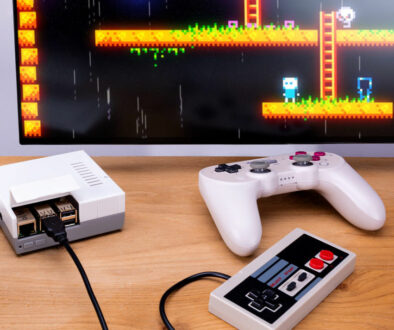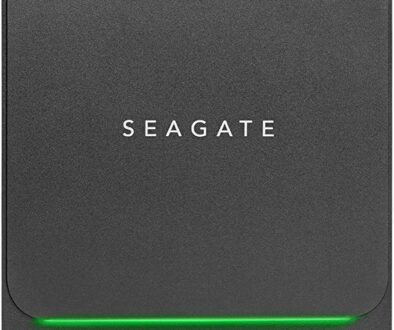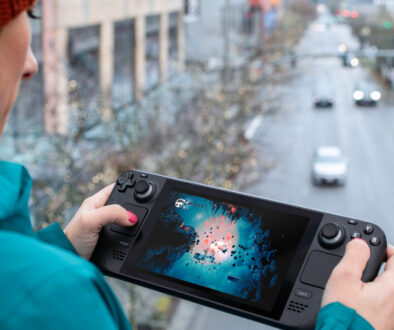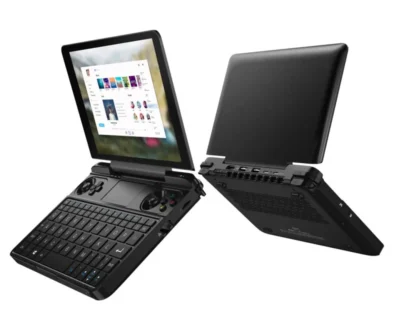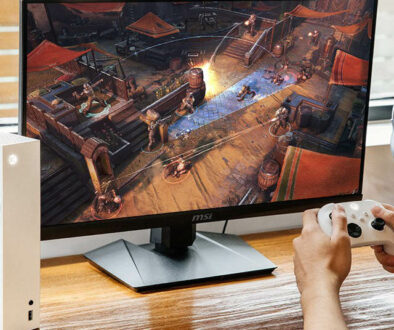Why the Steam Deck Can Both Succeed and Fail
In a move that instantly swept Nintendo’s feet off their vaunted Switch OLED announcement, Steam opened a power move and co-announced the Steam Deck within pretty much the same week. Even just looking at it on paper, and from the test videos/sample screenshots, opinions are already divided with regards to its actual worth.
As a portable device, it makes its combination of power and contours worth the attention away from other handheld PCs. But as a full computer, it is questionable whether it is really a viable alternative in the face of rising gamer standards.
So, would its launch succeed or fail? Well… there are sufficiently convincing arguments for both.
Steam Deck Announced Specs Recap
| CPU | 4-core/8-thread, 2.4-3.5Ghz Zen 2 Ryzen (up to 448 GFlops FP32) |
| GPU | 8-CU, 1.0-1.6Ghz RDNA 2 iGPU (up to 1.5 TFlops FP32) |
| Memory | 16GB LPDDR5 32-bit quad-channel 5500 MT/s (on-board) |
| Display | 7-inch 1280×800 60Hz IPS touchscreen |
| Battery | 2 hours at full charge (advertised) |
| Storage | Model 1: 64 GB eMMC (PCI-e Gen 2 x1)
Model 2: 256 GB NVMe SSD (PCI-e Gen 3 x4) Model 3: 512 GB NVMe SSD (PCI-e Gen 3 x4) |
(Note: Gabe Newell has since then also confirmed that the Steam deck’s M.2 slot is accessible and fully upgradeable with your choice of commercial 30mm NVMe SSDs. In addition, the RAM specs were later corrected from “dual-channel” to “quad-channel” as well)
Steam Deck Success Recipe: Competition Elevation
As with any business entity planning to make a splash into an already established space within the tech market, an offering that could potentially provide a huge leap is an inevitable necessity. Valve seems to have successfully done this with the official announcement of the Steam Deck. It didn’t actually make huge headlines with its specs initially at first. But, more and more people are starting to realize its potential to be yet another alternative outlet that could ease gamers’ woes in the current GPU crisis.
In fact, we can already see few elements of potential success, which are as follows:
Success Point 01: Impressive Specs
Currently owning a beast rig powered by a 5950X and 3090? Or maybe portable gaming just isn’t your style? There are many reasons why the average modern PC gamer would simply roll their eyes or raise their eyebrows at the sight of some portable APU machine. However, the devil is in the details, because two very important specs allow the Steam Deck to change the entire game for portable consoles.
First, is its APU
For the longest time in Ryzen’s half-a-decade stint towards competitive dominance, every single modern AMD APU that was ever released was based on the ageing Vega architecture. Don’t get the wrong idea. CPU like the Athlon 3000G did change the entire metagame for iGPUs moving forward. But they still remained in the realm of ultra-low-end. The dream of a 1050Ti-on-a-chip also remained an unattainable fantasy.
That is until the announcement of the Steam Deck’s new, custom APU. 8 CUs of RDNA 2 may not seem much, but the leap in generation and architecture to Vega is almost certain to allow it to readily break the RX 560/750 Ti threshold. Would it finally surpass the 1050 Ti? That’s the hope. Exceeding the current-generation “undying GPU” can certainly become the gateway for the portable Steam Deck to access the entire PC game library as advertised.
The second reason is its memory
APUs require a good amount of RAM, since its VRAM will also be taken from the same memory module. Reinforcing this is Ryzen itself, with its significant boosts to raw frames and framerate performance the higher memory frequencies are cranked up. Even further, good RAM allows the CPU and GPU to process more data per unit time, increasing its performance even further.
Steam Deck’s 32-bit quad-channel memory will be the direct answer to all of these requirements. While the 88GB/s bandwidth is numerically lower (compared to other consoles), percentage-wise, it is capable of delivering the entire floating-point-operation capacity of every CU of the RDNA 2 iGPU. This means, there will be no bottlenecks at any point of its operation at all, allowing the custom Ryzen 2 APU to unleash its number-crunching prowess even further.
Success Point 03: It’s a Transcended Steam Machine
Every single previous Steam Machine thus far has failed miserably one way or another, due to some critical inability in its implementation or operation. But, in a nutshell, most Steam machines proved to be too niche, and this is the very thing that the Steam Deck will attempt to solve.
Remember, these older machines were basically forced onto players with Linux-based operating systems that offer limited compatibility to games natively playable on Windows systems. Worse, these models tried to clash with PCs directly within the same product space. With very little innovation, smaller compatibility, and often weaker specifications (with stunted upgradeability), they simply couldn’t break the market and thrive.
From the get-go, things will be different from the Steam Deck. First is the problem of Windows game compatibility, which is effectively solved by present-day Linux updates and the current iteration of Proton. Second, it competes in a space that it could potentially dominate hardware-wise, and deftly evades direct competition with current monstrous (desktop) PC hardware.
Most importantly, it has a few innovations, or at least a combination of them, that is simply impossible to replicate right now by either traditional portable consoles/PCs or full desktop systems. The RDNA 2-based APU, for example, is one such feature.
And if all else SteamOS-related fails, it is a “Steam Machine” that can still install Windows another OS on it. “It’s a PC. Do whatever you want with it.”
Success Point 04: Reduced Accessibility by Scalpers, Zero Cypto Miner Interest
As a portable console, the Steam Deck is very much likely to evade shortage problems created by scummy scalpers and opportunistic crypto miners. Well yeah, the Steam Deck is still subject to current global chip shortage issues, as clearly shown by predicted shipments of the product. But, artificially created supply issues are not going to be a problem for it in the near future.
You see, even if scalpers are able to grab their hands on the console, the Steam Deck’s relatively niche-ish hype is never as widespread and general as, let’s say, PS5s, or even regular GPUs. So those looking for a quick buck on future marked-up units would predictably have a harder time trying to find a buyer desperate enough to get one at any price. Heck, scalpers would not even be able to profit right now. You simply cannot sell product reservations/pre-orders at eBay (and presumably other similar websites) unless the item is reasonably close to being physically available to the seller (30 days for eBay).
And as for crypto miners’ interest in the Steam Deck, the verdict should be obvious just by looking at its APU.
Steam Deck Failure Centerpoint: Complete Use Percentage
Conversely, if the Steam Deck does become unable to live the hype, we can most likely place the blame of several factors related to its adoption and implementation.
Which are namely:
Failure Point 01: It’s ‘Only’ Zen 2
Unfortunately, the very same thing that made it better than its competitors, would be the same thing that would potentially stunt its development in the next few years. As we move on to Unreal Engine 5, Intel 12th Gen’s ARM-like core architectures, and Ryzen 6000’s 6nm fab process, it is unknown whether Steam Deck will be able to keep up with its relatively “old” Zen 2 (Ryzen 3000) architecture.
Well sure, you can make the argument that anything Ryzen 1000/Intel 8th Gen and above would still remain relevant for the foreseeable future. But the Steam Deck is already working on reduced margins of 800p resolution, 60 FPS for lesser demanding titles, and 30 FPS for more intensive ones. Any (sufficiently hardware-optimized) new game that could potentially rock the desktop-entry-level position of the RX 580/GTX 1060 or Core i3-10100F/Ryzen 3 3300X would presumably also give the Steam Deck a hard time.
Failure Point 02: Still Unimpressive Battery Life
If the Steam Deck really wants to compete, it needs to crush the competition beyond recognizable measure. Not just in performance, but in practicality, and that includes battery life. Two hours may allow it to compete side-by-side with the Nintendo Switch, PS Vita, or even fellow portable PCs such as the GDP Win 3, OneXPlayer, and Aya Neo. But without an energy efficiency breakthrough, adoption rates might remain limited.
Ideally, we want to see at least four hours of battery life. This would be enough to last through several breaks throughout the day, gives you a very good opening for long trips, and at least for half a long-haul flight, you won’t have to borrow a plane outlet. Such battery life also allows the Steam Deck to approach somewhat near the typical battery life (for a day’s use) of other more typical portable tech, such as tablets and smartphones.
But alas, in this regard, its gaming performance ironically becomes the very cause of this drawback.
Failure Point 03: Ambiguous Use Case (as a PC Gamer)
In a world of modern gaming where out-of-touch enthusiasts continue preaching the grossly erroneous claim that “an 8-core CPU is the minimum triple-A gaming requirement”, promoting the use of something even more inferior for the sake of portability will always remain to be a tough sell.
Okay, maybe you plan to buy into the Steam Deck hype all along. Then what? Are you going to use it as often as you can? Even for the sake of being portable, are you really ready for the sacrifice of playing (what originally should be) desktop games on a significantly tinier screen, with frame rates and reduced game settings that you used to ridicule and criticize RX 570 owners with?
If you haven’t owned a PC yet, would you pass up the opportunity to build an office machine that doesn’t need to have gaming-ready specs? Especially if the rest of the funds were already allocated for the Steam Deck? And if you intend to build up the PC’s spec so as not “waste” its total functionality, then we’re simply back at the previous question of playing with limitations.
Not to say that there won’t be super-efficient use cases for the Steam Deck (looking at you, third-person action, turn-based tactical titles, and emulation!). But much like its other portable PC predecessors, you need to match it with a game library that won’t significantly feel different to play either on desktop or on mobile.
As the current DIY PC building community stands, such a scenario is looking quite unlikely at the moment.


